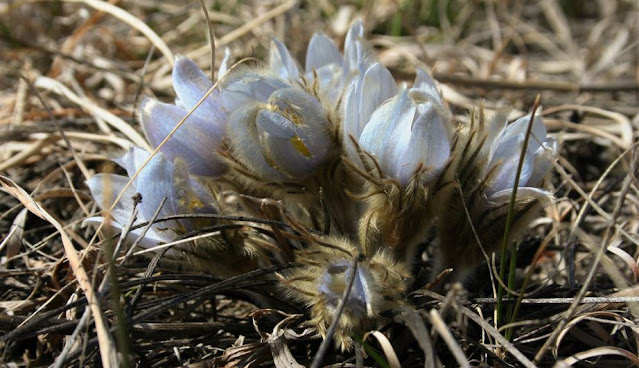 |
| Pasque Flower, Anemone patens, on April 19, 2022, at Crow Hassan Park Reserve. |
These Pasque Flowers were barely open on a cool April day, but as they expand, their bowl shapes will track the sun like tiny reflective dishes. The movement of the flowers, called heliotropism ("sun turning") keeps them warmer than their surroundings, providing an inviting place for pollinators to land.
Heliotropism is one of many adaptations Pasque Flower has to emerging and flowering early on the prairie, when conditions are unstable. Its spring phenology offers the benefit of less competition for water, light and pollinators, but it comes with the risk of late frosts and cold, windy weather that inhibits insect activity.
Other adaptations include long hairs to blunt the effects of cold winds and chemical irritants that discourage herbivores from chomping on the first greens of the season. Crushed or chewed leaves contain protoanemonin, a molecule that irritates the digestive system. The same molecule can produce blistering rashes on the hands of wildflower-picking humans.
Where to Find Pasque Flower
Pasque Flower is a native perennial of dry prairies and open woods. It grows throughout much of Minnesota except for counties in the northeast. For a range map, see this Minnesota Wildflowers webpage.
Pasque Flowers and Climate Change
Like other early spring perennials, Pasque Flower is especially sensitive to temperature, so this species is useful to observe for the effects of a warming climate. Around 2010, Elisabeth Beaubien and Andreas Hamann, two researchers studying the phenology of plants in the Central Parklands of Alberta, Canada, found that Pasque Flowers bloomed an average two weeks earlier than decades ago. The shift in phenology corresponded to increases in average temperature during the same period, 1936-2006.
The two-week difference was greater than Beaubien and Hamann expected based on a thermal time model, a tool that predicts flowering time by adding accumulated degrees above a base value. They suspect increases in nighttime temperature are largely responsible for the shift.
Their paper is here.



